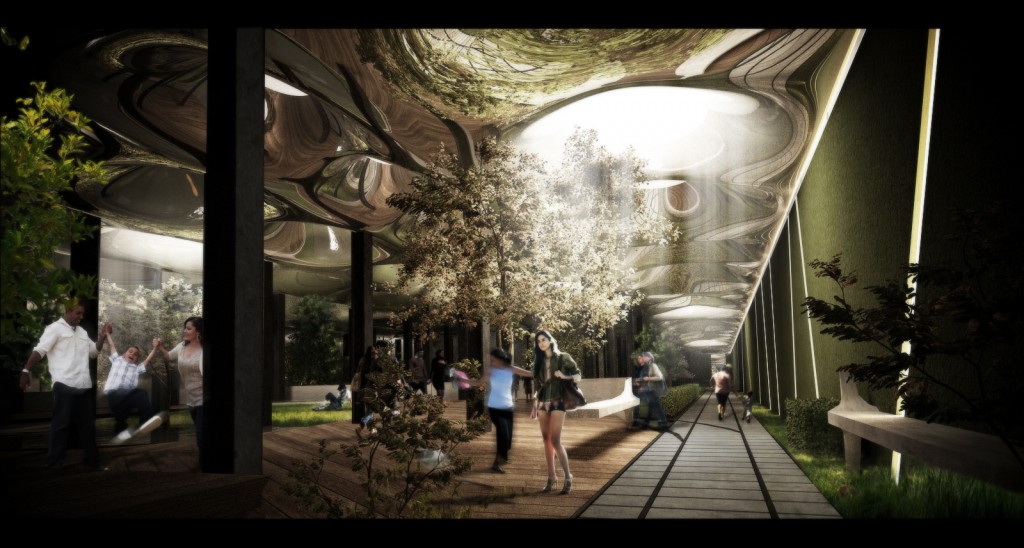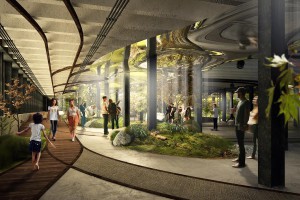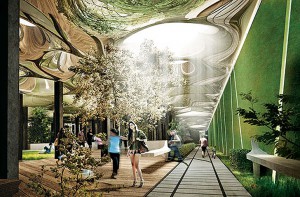Share This
Related Posts
Tags
Under Delancey Street
By Cutright Elizabeth on Dec 1, 2015 in News
A new era of metropolitan re-use and restoration is taking hold in cities around the world. On New York’s Lower East Side, two visionaries are taking the urban greenspace  movement to the next level by putting it underground. With a planned debut in 2020, the LowLine project promises to create a calm, cultivated woodland atmosphere in an abandoned trolley terminal sprawled out beneath Delancey Street.
movement to the next level by putting it underground. With a planned debut in 2020, the LowLine project promises to create a calm, cultivated woodland atmosphere in an abandoned trolley terminal sprawled out beneath Delancey Street.
Buried in New York’s Lower East Side lives a secret space and futuristic opportunity. In 1908, the Williamsburg Bridge Trolley Terminal debuted. The one-acre property located under Delancey Street primarily served trolley passengers traversing Manhattan’s submerged passageways. Though it’s been shuttered for more than 60 years, the original vaulted ceilings and cobblestone walkways still sit, patiently waiting for a new era of city residents to venture below.
If James Ramsey and Daniel Barasch have their way, those Big Apple visitors will soon be enjoying a belowground wonderland, outfitted with hidden nooks, man-made stalagmites, trees and maybe even a hitchhiking frog or two all lit-up by the latest in solar-refraction technology. Christened the LowLine, this subterranean greenspace is part botanical garden, part laboratory, and part social experiment. For co-founders Ramsey and Barasch, the LowLine offers the chance to add much-needed greenery to one of the city’s most urban environments.
A Shared Vision
Manhattan’s Lower East Side represents a microcosm the borough’s transformation from humble, insular neighborhood into a jubilant melting pot of immigrants, boutique businesses, corporate high-rises and creative visionaries. When Ramsey learned of the Williamsburg trolley terminal in 2008, he was struck by its potential. He envisioned plants and trees thriving in a sort of “park” that would benefit the entire community.
“It’s not every day that you find 60,000 square feet in New York, right?” Ramsey recently stated in an interview with TWC News.
“In a city really defined by scarcity, we need to think more creatively about how we use and reuse the spaces that we already have built,” added LowLine co-founder Dan Barasch.
Back in 2008, Barasch was working to install artwork in the subway system as part of his own vision of repurposing unused spaces in the city. The two co-founders saw the chance to try something new and immediately began searching for a way to make their dream a reality. After a record-breaking Kickstarter campaign brought in over $150,000, supporters began championing the plan and even nine city officials drafted a letter encouraging the City to back the project.
A second Kickstarter in 2015 raised another half a million in funds for the LowLine, enabling the creation of the much anticipated “LowLine Lab,” which will open in early 2016. The lab will showcase the space’s cutting edge technology and include a variety of cultural and community events and contributions.
Harnessing Sunlight
The LowLine’s solar technology and design make it sound like science fiction, but the woodsy environment it will  create hearken back to an era of small town meeting spots and rural playgrounds full of leafy corners and cheerful wildlife.
create hearken back to an era of small town meeting spots and rural playgrounds full of leafy corners and cheerful wildlife.
“It’s futuristic for sure, but this is not a magic trick. This is real math and science that enables us to do this,” Ramsey explained in a New York Daily Interview.
In the most basic terms, the project’s solar technology involves the use of a “remote skylight” that will pass sunlight through a glass shield that will then project the light through a series of reflectors. During the daytime, the LowLine will have no need of electricity for lighting purposes, and because the technology transmits the wavelengths necessary for photosynthesis, LowLine will be able to sustain up to 60 species of plants.
As the website devoted to the project details, “The LowLine aims to build a new kind of public space— one that highlights the historic elements of a former trolley terminal while introducing cutting-edge solar technology and design, enabling plants and trees to grow underground.”
Surreal and Psychedelic
As it begins to take shape, it’s clear the LowLine will invigorate the Lower East Side and provide the community – along with tourists and visitors from neighboring boroughs – the chance to walk along flowerbeds and across wooden walkways to the sounds of a kinetic, boisterous combination of playful children and cheerful fauna. There will be wooden walkways, hidden alcoves, and perhaps even a rainbow or two!
“I want people to come into this space … and just to have a moment of transcendence where they can really imagine that they are in this alternate world,” rhapsodized Ramsey in that New York Daily Interview. “It’s pretty surreal and maybe even a little bit psychedelic.”
Living in the Future
Protected from the highs and lows of New York’s seasonal weather, visitors to the LowLine can escape the frenetic pace of the city for a respite amongst the old trolley terminal’s tracks and cobblestones, but first several bureaucratic and political hurdles must first be overcome. Though success is not guaranteed, Barasch and Ramsey’s passion for the project is convincing skeptics and bringing in millions in donations and corporate sponsorship along with the support of New York celebrities like Lena Dunham, Spike Jones and Laura Prepon.
“It really feels like we are living in the future,” Dunham declares in a video highlighting the project.
Ramsey and Barasch want to change how cities use public space and they hope the LowLine demonstrates how the latest technologies can help bring more green places to urban locations.
“We envision not merely a new public space, but an innovative display of how technology can transform our cities in the 21st century,” the duo’s website declares. “And along the way, we intend to draw the community into the design process itself, empowering a new generation of Lower East Siders to help build a new bright spot in our dense urban environment.”
